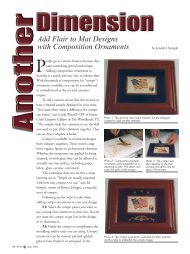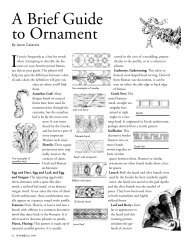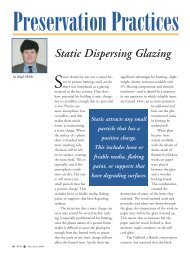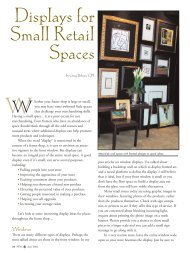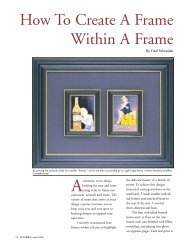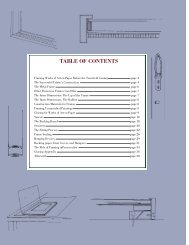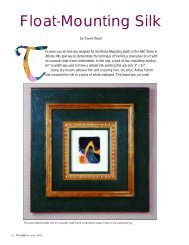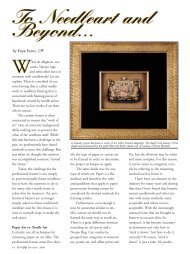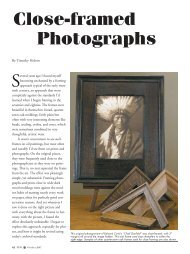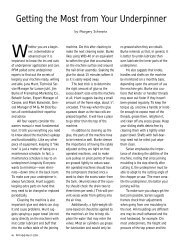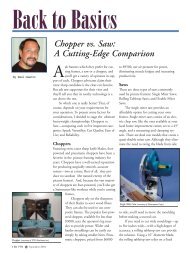Hinges and Floated Artwork - Picture Framing Magazine
Hinges and Floated Artwork - Picture Framing Magazine
Hinges and Floated Artwork - Picture Framing Magazine
Create successful ePaper yourself
Turn your PDF publications into a flip-book with our unique Google optimized e-Paper software.
potential for weight<br />
bearing with superior<br />
T-peel <strong>and</strong> shear<br />
strength, the Vhinge<br />
sacrifices that<br />
strength for being<br />
invisibly hidden<br />
behind the art. A Vhinge<br />
should always<br />
be reinforced with a<br />
horizontal crosspiece<br />
to prevent it from<br />
peeling off due to gravity <strong>and</strong>/or<br />
the weight of the art on which it is<br />
used (see Diagram 2).<br />
As with T-hinges, the reinforced<br />
horizontal strip applied<br />
over the adhered V-hinge may be<br />
made of rice paper, a pressure-sensitive<br />
tape approved for use with<br />
hinges, or a gummed paper tape<br />
(see Photo 2). Unlike the pendant<br />
hinge, these are often placed horizontally<br />
so the length of the hinge<br />
is pasted to the art, rather than<br />
vertically—with the width or narrowest<br />
portion attached to the art.<br />
S-<strong>Hinges</strong><br />
Whether called an S-hinge, pass<br />
through, folded, suspension tab, or<br />
concealed pendant hinge, this<br />
method is one that allows the art<br />
to visually float in the center of<br />
the frame. These hinges are<br />
mounted on one end to the back<br />
of the art while the other end is<br />
fed through the backing board <strong>and</strong><br />
mounted to the back of the<br />
mounting board (see Photo 3).<br />
The S-hinge is first mounted<br />
to the back side of the art <strong>and</strong><br />
allowed to dry. Slots are cut in the<br />
backing board at the proper position<br />
just slightly wider than the<br />
hinge. The sharp paper edges of<br />
the 4-ply board should be rounded<br />
to prevent cutting of the rice paper<br />
48 PFM _ December 2004<br />
Photo 2: V-Hinge—This hinge is similar to a pendant<br />
hinge (discussed last month) but is placed on<br />
the back of the art <strong>and</strong> folded back onto itself<br />
(left hinge). If reinforced with a crosspiece, it is<br />
drastically strengthened (right hinge).<br />
Photo 3: S-Hinge (or Pass Through)—The<br />
hinge is fitted through a slot that has been<br />
cut into the backing board to be affixed to<br />
the back of the mount board. This photo<br />
shows the hinge, already glued to the art<br />
with starch paste, after it has been fed<br />
through the prepared slot in the backing.<br />
hinges when they are being passed<br />
through, or otherwise h<strong>and</strong>led.<br />
Next, the hinges are fitted through<br />
the slots in the backing board (see<br />
Diagram 3) <strong>and</strong> glued to the back<br />
of the mount board, out of sight.<br />
As with the V-hinge described<br />
above, the basic S-hinge is subject<br />
to peel failure if the frame is rotated<br />
or mish<strong>and</strong>led <strong>and</strong> the weight of<br />
the art is allowed to pull against the<br />
hinge. Therefore, the S-hinge<br />
should be reinforced with a horizontal<br />
crosspiece as with the Thinge<br />
or the reinforced V-hinge.<br />
Jumbo <strong>Hinges</strong><br />
Another option to help reinforce a<br />
thin hinge is to create a jumbo<br />
hinge. The jumbo hinge is a bit of<br />
a hybrid in that it is a st<strong>and</strong>ard<br />
strip of mulberry rice paper that<br />
has been wet feathered 1" wide<br />
<strong>and</strong> 4" to 6" long. It is folded at<br />
its midpoint <strong>and</strong> glued together<br />
with starch paste—except for a 1 /4"<br />
section at each end—to create a<br />
double thick hinge. Those last 1 /4"<br />
ends are left unglued <strong>and</strong> flared<br />
out into a “T” shape for mounting<br />
to the art (see Photo 4).



